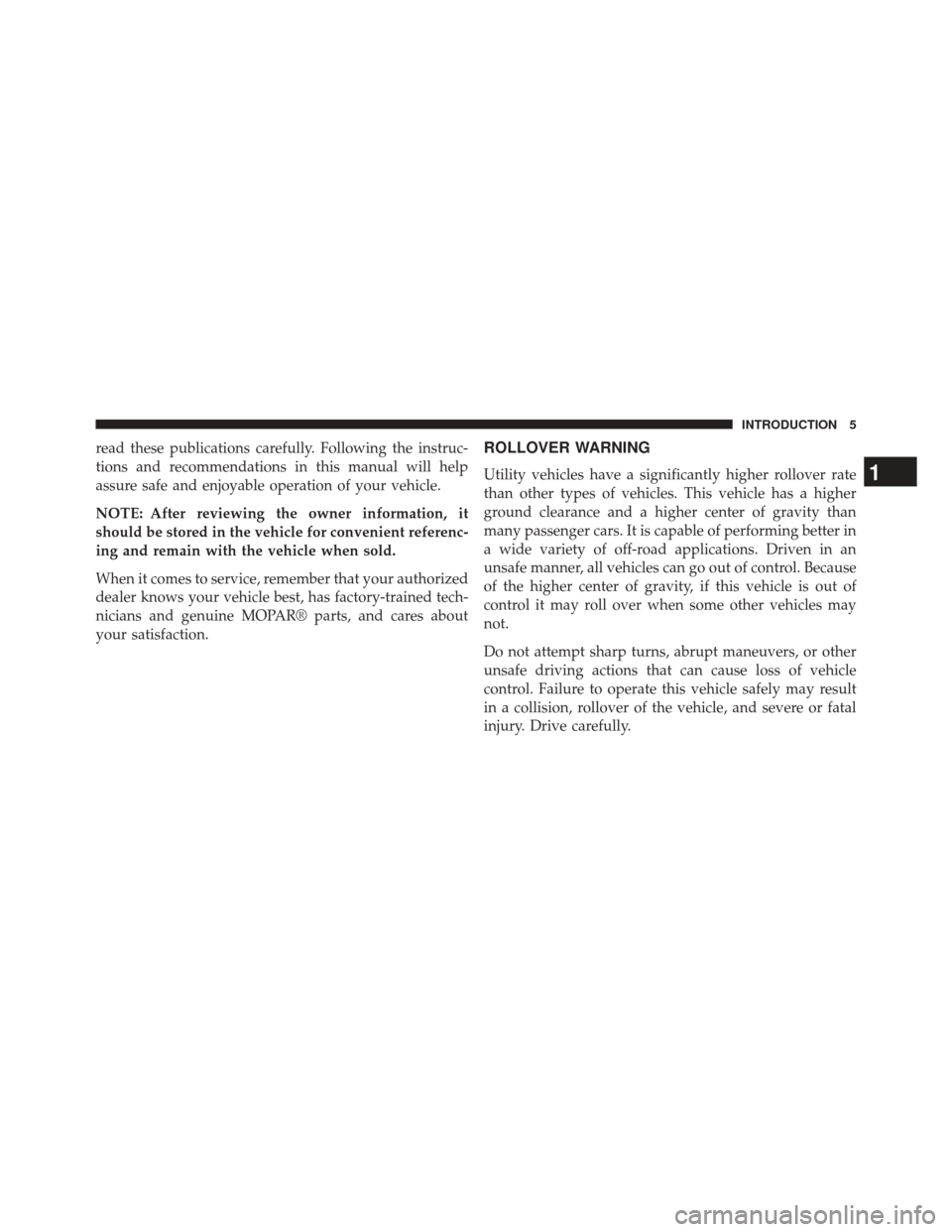Page 7 of 674

read these publications carefully. Following the instruc-
tions and recommendations in this manual will help
assure safe and enjoyable operation of your vehicle.
NOTE: After reviewing the owner information, it
should be stored in the vehicle for convenient referenc-
ing and remain with the vehicle when sold.
When it comes to service, remember that your authorized
dealer knows your vehicle best, has factory-trained tech-
nicians and genuine MOPAR® parts, and cares about
your satisfaction.ROLLOVER WARNING
Utility vehicles have a significantly higher rollover rate
than other types of vehicles. This vehicle has a higher
ground clearance and a higher center of gravity than
many passenger cars. It is capable of performing better in
a wide variety of off-road applications. Driven in an
unsafe manner, all vehicles can go out of control. Because
of the higher center of gravity, if this vehicle is out of
control it may roll over when some other vehicles may
not.
Do not attempt sharp turns, abrupt maneuvers, or other
unsafe driving actions that can cause loss of vehicle
control. Failure to operate this vehicle safely may result
in a collision, rollover of the vehicle, and severe or fatal
injury. Drive carefully.1
INTRODUCTION 5
Page 425 of 674

•Mud – Off road calibration for use on low traction
surfaces such as mud. Driveline is maximized for
traction. Some binding may be felt on less forgiving
surfaces. The electronic brake controls are set to limit
traction control management of throttle and wheel
spin. If equipped with air suspension, the level will
change to Off-Road 1.
• Rock – Off-road calibration only available in 4WD
Low range. The vehicle is raised (if equipped with Air
Suspension) for improved ground clearance. Traction
based tuning with improved steer-ability for use on
high traction off-road surfaces. Activate the Hill De-
scent Control for steep downhill control. Use for low
speed obstacles such as large rocks, deep ruts, etc. If
equipped with air suspension, the vehicle level will
change to Off-Road 2. If the Selec-Terrain™ switch is in
ROCK mode, and the transfer case is switched from
4WD Low to 4WD High, the Selec-Terrain™ system
will return to AUTO.Electronic Vehicle Information Center (EVIC)
Display Messages
When the appropriate conditions exist, a message will
appear in the EVIC display. Refer to “Electronic Vehicle
Information Center (EVIC)” in “Understanding Your
Instrument Panel” for further information.
QUADRA-LIFT™ — IF EQUIPPED
Description
The Quadra-Lift™ air suspension system provides full
time load leveling capability along with the benefit of
vehicle height adjustment by the push of a button.
5
STARTING AND OPERATING 423
Page 426 of 674

•Normal Ride Height (NRH) – This is the standard
position of the suspension and is meant for normal
driving.
• Off-Road 1 (OR1) (Raises the vehicle approximately
1.28 in (32.5 mm) – This is the primary position for all
off-road driving until OR2 is needed. A smoother and
more comfortable ride will result. Press the “Up”
button once from the NRH position while the vehicle
speed is below 38 mph (61 km/h). When in the OR1
position, if the vehicle speed remains between 40 mph
(64 km/h) and 50 mph (80 km/h) for greater than 20
seconds or if the vehicle speed exceeds 50 mph
(80 km/h), the vehicle will be automatically lowered to
NRH. Refer to “Off-Road Driving Tips” in “Starting
and Operating” for further information.
• Off-Road 2 (OR2) (Raises the vehicle approximately
2.6 in (65 mm) – This position is intended for off-
roading use only where maximum ground clearance is
Selec-Terrain™ Switch
1 — Up Button
2 — Down Button
3 — Entry/Exit Mode Indicator Lamp (Customer Selectable)
4 — Normal Ride Height Indicator Lamp (Customer Selectable)
5 — Off-Road 1 Indicator Lamp (Customer Selectable)
6 — Off-Road 2 Indicator Lamp (Customer Selectable) 424 STARTING AND OPERATING
Page 432 of 674

indicator lamp 4 will remain on solid and indicator
lamp 3 will flash as the system waits for the vehicle to
reduce speed. If vehicle speed is reduced to, and kept
below, 15 mph (24 km/h) indicator lamp 4 will turn off
and indicator lamp 3 will flash until Entry/Exit Mode
is achieved at which point indicator lamp 3 will go
solid. If during the height change to Entry/Exit Mode,
the vehicle speed exceeds 15 mph (24 km/h), the
height change will be paused until the vehicle speed
either goes below 15 mph (24 km/h) and the height
change continues to Entry/Exit Mode, or exceeds
25 mph (40 km/h) and the vehicle height will return to
NRH. Entry/Exit Mode may be selected while the
vehicle is not moving provided that the engine is still
running and all doors remain closed.
• Transport Mode - No indicator lamps will be illumi-
nated. Customer driving will disable Transport Mode. •
Tire/Jack Mode - indicator lamps 3 and 6 will be
illuminated. Customer driving will disable Tire/Jack
Mode.
• Wheel Alignment Mode - indicator lamps 3 and 4 will
be illuminated. Customer driving will disable Wheel
Alignment Mode.
ON-ROAD DRIVING TIPS
Utility vehicles have higher ground clearance and a
narrower track to make them capable of performing in a
wide variety of off-road applications. Specific design
characteristics give them a higher center of gravity than
ordinary cars.
An advantage of the higher ground clearance is a better
view of the road, allowing you to anticipate problems.
They are not designed for cornering at the same speeds as
conventional two-wheel drive vehicles any more than
430 STARTING AND OPERATING